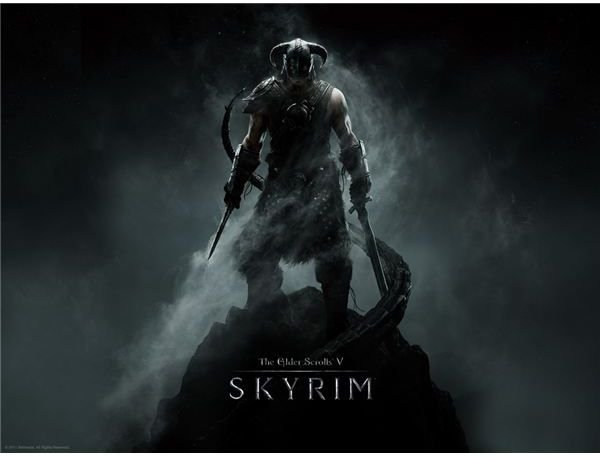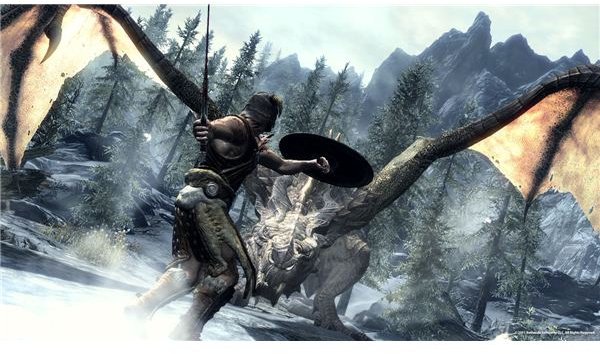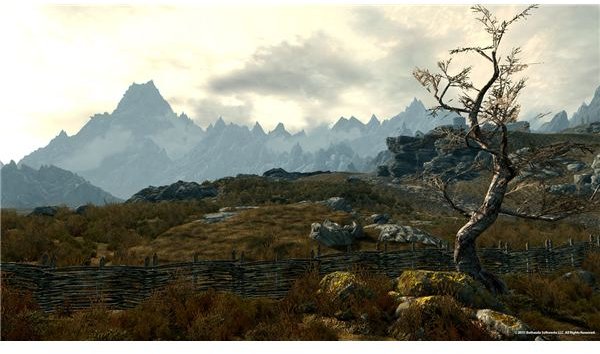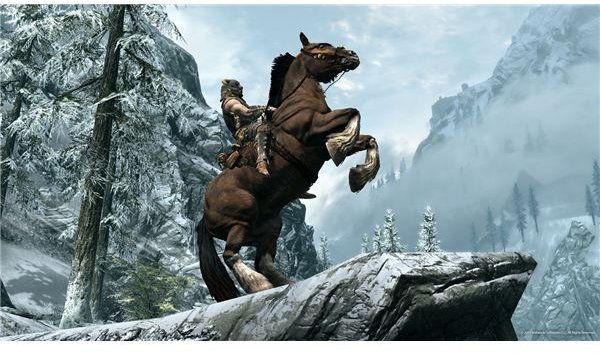The Ultimate Skyrim PC Review: What You Need to Know

The Tale of Skyrim (Story) (4 out of 5)
Here, thar be dragons.
Okay, you already knew that. Bethesda has been waving its dragons around ever since it announced they would be a part of the game, and for good reason. Dragons are cool, particularly when they’re made out of millions of polygons and textured with outrageous detail.
The inclusion of dragons in Skyrim is much more than just a marketing tool, however. They’re an integral part of the story, and more tightly woven into Skyrim than any previous threat represented by the series. Both Morrowind and Oblivion shared in a story that did a poor job of instantly showing the player the game’s primary threat, but in Skyrim, the dragons are in your face from the very beginning. If you follow the main story, you’ll have had close encounters with several within the first ten hours of the game.
Unfortunately, not all the story woes found in Bethesda games are rectified. While the studio seems to be dialing in on how to construct a grand, open plot, there’s still a lack of truly interesting main characters. Most can be boiled down to a few simple clichés – noble king, tough woman, violent rebel who believes the ends justify the means.
It’s not hard to excuse these problems, however, because there’s simply so much going on. While you advance the main plot, there’s a buffet of side-quests available. Everyone seems to have something that needs fixed, and you’re just the person to do it. While it can be distracting (for those who want to complete the main quest quickly) it does an excellent job of conveying a sense of life to the world.
The core of the game, then, is nothing new. Like previous games in this franchise, the broad details of the world and the plot matter more than specific characters and plot points. Bethesda has done a better job of letting players dive right in to the meat of the story, but this is still a vague epic rather than a detailed one. Only a few major points are filled out – the rest is up to you.
Getting Your Fight On (Gameplay) (4 out of 5)
Like previous Elder Scrolls games, Skyrim is designed to be played from the first-person perspective. This makes combat different from many other fantasy games, which usually rely on top-down or third-person control.
There are some changes, however. Skyrim has introduced a new dual-wield mechanic that is an integral part of the game’s combat system. Every offensive item or spell in the game takes up one of your hands – left or right. This means that if you want to be a spellsword, you can equip a one-handed sword and a fire blast spell at the same time.

You may think this sounds like freedom, but as veterans from previous games will quickly note, it’s actually a bit restricting. You see, in previous games you could use spells at any time you’d like while having any weapon out as well, with the only restriction being that you could not perform a weapon attack and spell attack at the same time. That’s no longer possible.
With magic no longer as easy to access, characters have less chance to hybridize, which has the effect of making Skyrim a bit more difficult than previous titles, where it was very easy to level up Restoration and heal yourself constantly while wielding any weapons you’d like.
It’s not just the dual-wield system that encourages more specialization. Bethesda has also introduced perks, an idea no doubt learned from the company’s experience designing Fallout 3. Skills level up as you use them, which in turn cause your character’s level to advance. At each character level, you can pick a perk. But there’s a level 50 soft cap, so you only have enough levels to flesh out all the perks on four or five skill trees. For hybrid characters, this will result in difficult decisions.
There is one mechanic that allows for some fooling about, however – shouts. An important part of the plot, shouts are basically spells that aren’t cast by hand but rather conveyed through voice. Because of that, you don’t have to equip them like other powers. They become powerful as the game progresses, and just as importantly, they’re fun to use. One early shout lets you dash across a short distance in the blink of an eye, for example.
Personally, I think Skyrim is a mechanical improvement over previous games, as there’s no longer an easy path through which players can create nigh-invincible hybrid characters. New players won’t know the difference, of course, and should enjoy the slash-and-cast playstyle of Skyrim, where success depends heavily on how you manage your available skills and available resources (magika, health and endurance).
Consolization Strikes Again (UI and Controls) (2 out of 5)
Skyrim, like virtually all new high-profile games, was developed simultaneously for consoles and the PC. Unfortunately, this has an immediately apparent impact on the game’s controls. Much of the interface uses WASD, which takes some getting used to. You can use the mouse, of course, but there’s something a bit off about how the mouse works (in the interface, at least). It feels sloppy and difficult to control.
The main character menu, through which players access the map, their items and their spells, is an obvious console cop-out. It consists of four options, laid out in the manner of a console D-pad. This make sense on the Xbox, but on a PC, it doesn’t make much sense.
After a few days, these issues can become frustrating enough to seriously spoil the experience. No matter how much I played with keyboard and mouse, certain controls never felt right. Why does Q control Favorites, for example?
I solved these issues by hooking up my Xbox 360 controller to my PC. If you own an Xbox 360, you can purchase an adapter and do that, too. The game is much smoother on the controller it was really designed for, but it’s a shame that Bethesada, often thought of as a PC-friendly developer, was cynical enough to release a crippled user interface.
Still a Looker? (Graphics) (5 out of 5)

Perhaps the reason that the UI is so poor is that the graphics are so good. If you own a high-end gaming computer, you’ll quickly be willing to forgive Bethesada of slaughtering your family, never-mind the UI.
Skyrim is beautiful not just because the polygon counts are mind-boggling or because the textures are among the best in the industry today. It’s also because, to the relief of many fans, Bethesada decided upon a setting that is naturally beautiful.
Oblivion was one of the most demanding games of its day when it was released, but it was sometimes dull. The setting was generic fantasy. Green fields. Big stone towers. Whatever. It was a step back from the twisted wasteland of Morrowind, with its strange architecture and savage landscapes.
Skyrim, on the other hand, is a land of piece and calm. High, snow-capped mountains are never far from view but often shrouded in the best mist ever rendered in a video game. Dungeons, though still obviously made from templates and tools, offer more graphical variety than ever. And then night falls, and the northern lights stretch across the sky. It’s cold, it’s lonely, and it’s beautiful.
That Voice Sounds Familiar (Sound) (4 out of 5)
Voice acting in Skyrim is thankfully not terrible, though not always great. As mentioned in the Story section of this review, most characters are one-dimensional. The voice actors can’t break this. In addition, Bethesda has yet again made the mistake of hiring people geeks know too well. Yes, Michael Hogan of Battlestar Galactica fame does an excellent job portraying Imperial General Tullius, but it’s impossible not to have flashbacks to Saul Tigh whenever he speaks.
Fortunately, the music is excellent. The Nordic theme of Skyrim gave plenty of materials, and as a result the soundtrack is composed of strong Viking drum-chants as well as peaceful riverside tunes that will accompany you whenever you’re not spilling blood over up and down this oh-so-pretty continent.
Buy It! (4 out of 5)

Skyrim is a nearly perfect Elder Scrolls game. It keeps all the refinements made in Oblivion – and makes many further refinements of its own – but also returns the series to a unique landscape that is stunning and engaging to explore. Given that exploration is a major part of all the Elder Scrolls games, this is a trait that is at least as important as the game’s excellent graphics and more difficult combat.
The one weakness that mars the PC versions is the poor UI. There’s no excuse for it, but it’s also not enough to ruin an otherwise superb game. That goes double if you don’t mind playing with the Xbox controller. Yes, it may seem like blasphemy, but this is not a precision game. Any reflexes lost in your mouse-hand are more than made up for by an interface that finally feels right.
Elder Scrolls fans should definitely buy this game, as it contains everything they’ve ever wanted while getting rid of yet more of the little problems that fans have previously endured. Most other gamers will want to buy it, too. It’s a massive title, so even if you only complete the main quest, you’ll have a good 30 hours of enjoyment. Go beyond and, well, you better hope you have some sick days left at work.
References
- Author’s own experience was used as basis for this review
- Image Credits: Bethesda
This post is part of the series: Skyrim Review & Previews
A collection of reviews from both before and after the official release of Elder Scrolls V: Skyrim.
